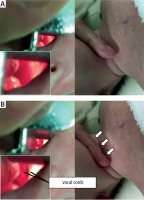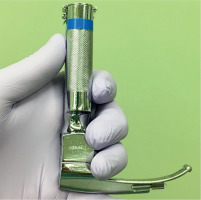Dear Editor,
The BURP (backward, upward, rightward pressure) maneuver to the thyroid cartilage is performed to dislocate the larynx of the patient in three directions: posteriorly, superiorly, and laterally to the right [1]. Pressure can be put on the thyroid cartilage only posteriorly to displace the larynx of the patient backward (Back maneuver) [2].
The BURP maneuver is reported as an advanced technique of the Back maneuver [1]. These are well-known techniques in laryngoscopy and are reportedly efficient in improving the visualization of the larynx for tracheal intubation [3]. However, it has also been reported that the BURP maneuver performed on the cricoid cartilage [4] or cricoid pressure (Sellick’s maneuver) [5–7] increases difficulty with ventilation and worsens the glottic view in laryngoscopy in some patients. In addition, the application of the BURP maneuver to the cricoid cartilage instead of the original site at the thyroid cartilage during rapid sequence anaesthesia induction has no protective benefit for patients [8].
In recent decades, instruments such as video laryngoscopes have been developed and their efficacy for difficult airways has been reported in paediatric patients [9] as well as in adults. However, even though small-sized blades for video laryngoscopy of paediatric patients have been developed, they are still too big to be applied to newborns or pre-term babies. Therefore, conventional direct Macintosh or Miller laryngoscopes are the only devices that can be used in such cases. A study of cadavers reported that bimanual laryngoscopy is more effective in improving the glottic view as compared to Sellick’s maneuver, BURP maneuver, and no manipulation [10]. In practice, physicians inadvertently use this bimanual technique, as they push the throat of the patient with the right hand to find the best possible glottic view before taking the endotracheal tube in their right hand to intubate the patient. However, in this technique, an assistant needs to provide the intubating physician with a similar glottic view during the tracheal intubation procedure, because the intubating physician is required to release the throat pressure to hold the endotracheal tube in his/her right hand.
Since instructing the assistant regarding the optimal direction and strength of pressure is not easy, the physician can push the thyroid cartilage of the patient with his/her own little finger, using the “self-BURP maneuver”, to get the best view of the vocal cord for intubation (Figure 1). The laryngoscope should be held with three digits – the thumb, index finger, and middle finger (Figure 2) – to allow the little finger to be used freely for the self-BURP maneuver [11]. This self-BURP maneuver is applicable not only in children but also in patients of all ages, as long as the little finger of the intubating physician reaches the throat of the patients.
FIGURE 1
Self-BURP maneuver with the size 1 Macintosh laryngoscope blade. A) The vocal cords of the patient are not fully visible before the self-BURP maneuver was performed. B) The vocal cords become visible when the patient’s thyroid cartilage is pushed by the intubating anaesthesiologist’s little finger (⇑) (“self-BURP maneuver”)






